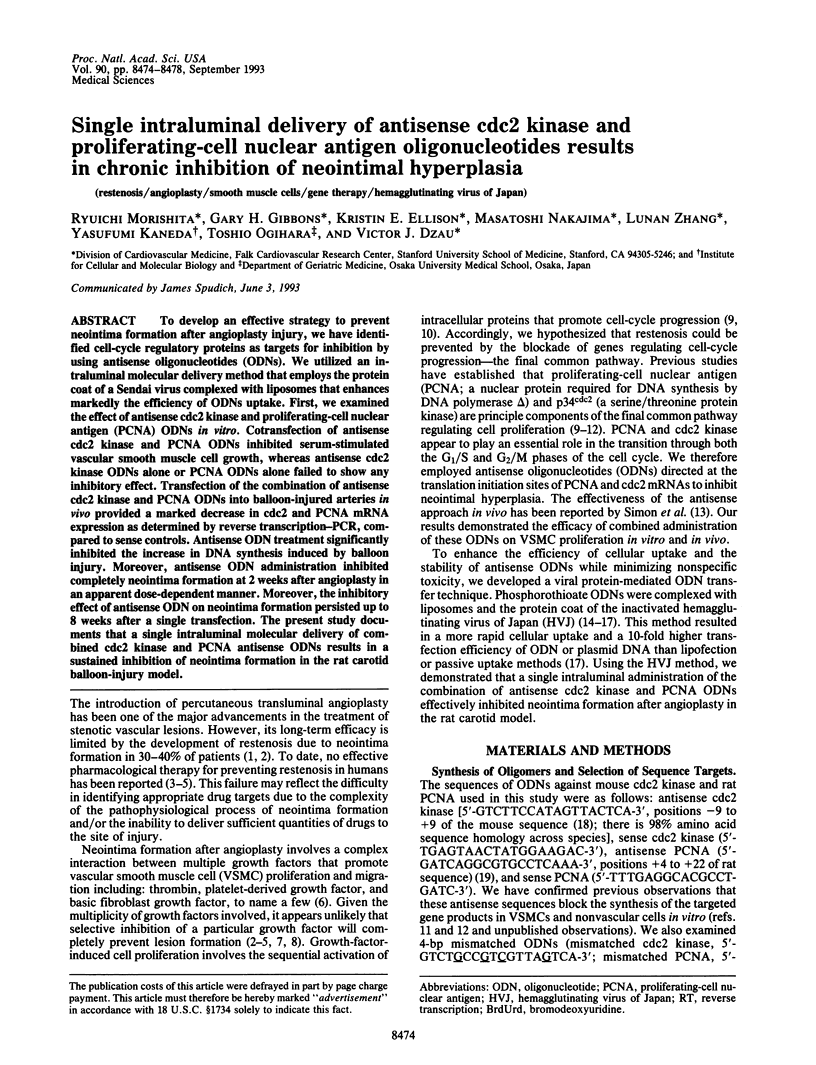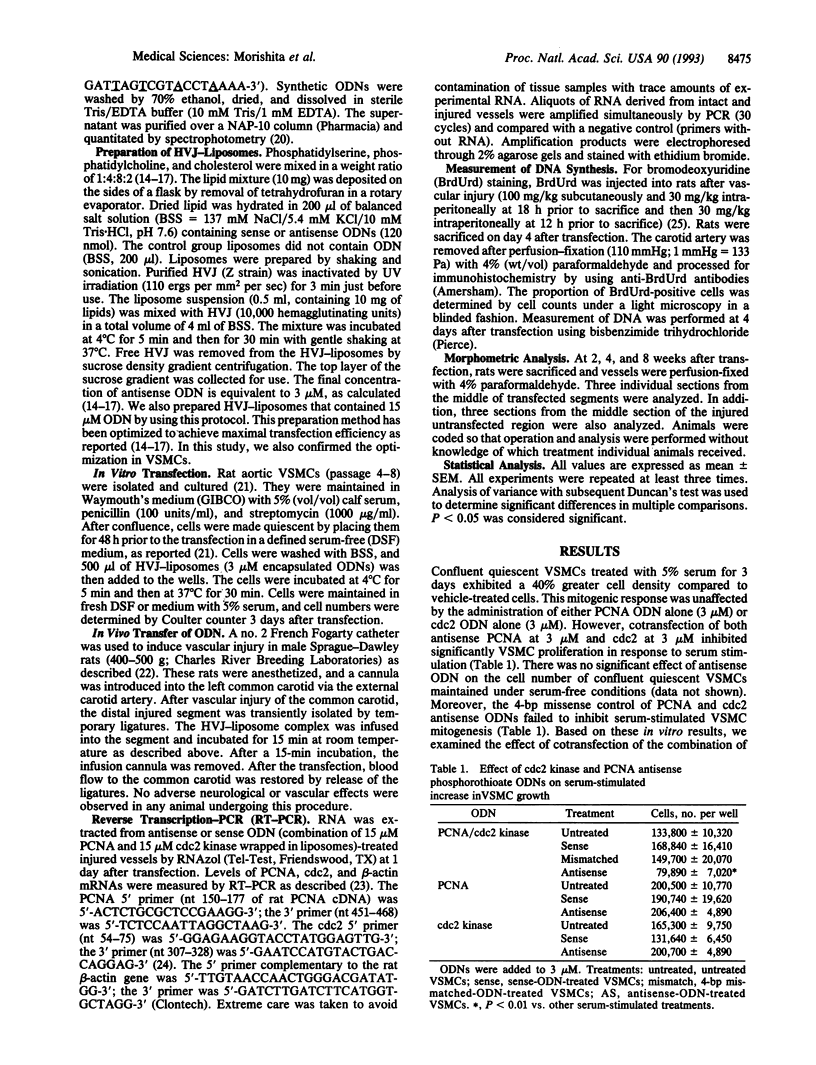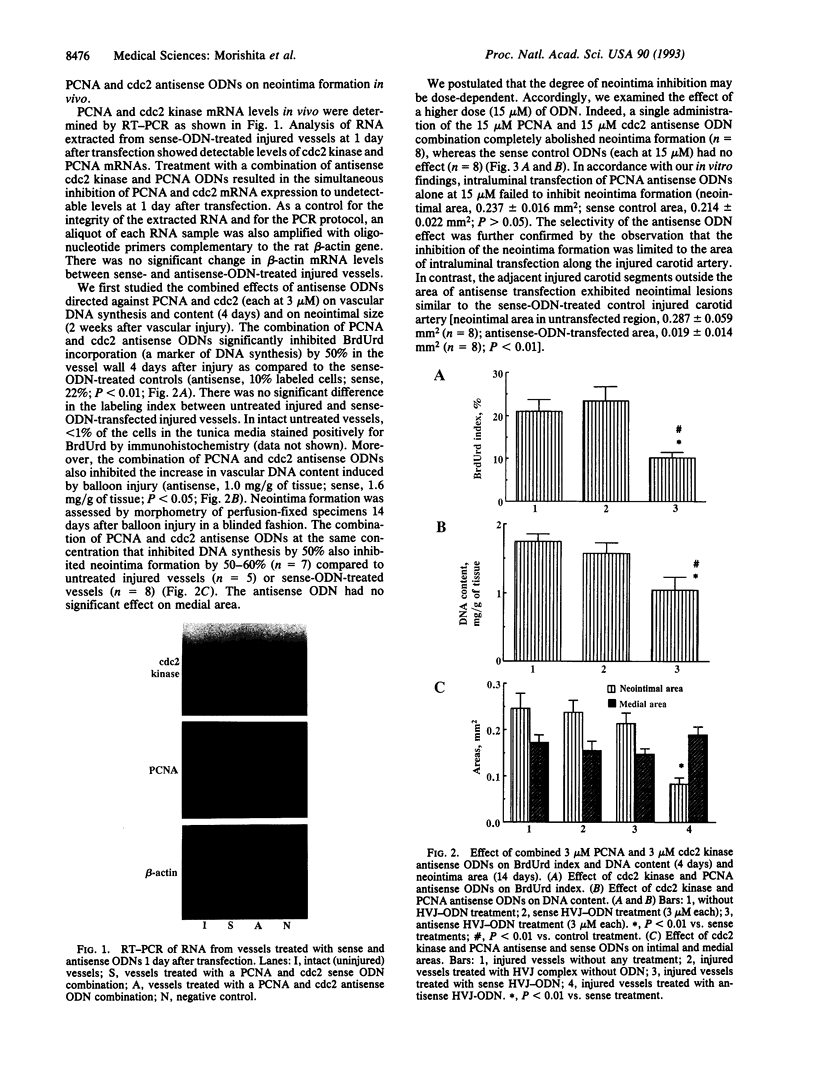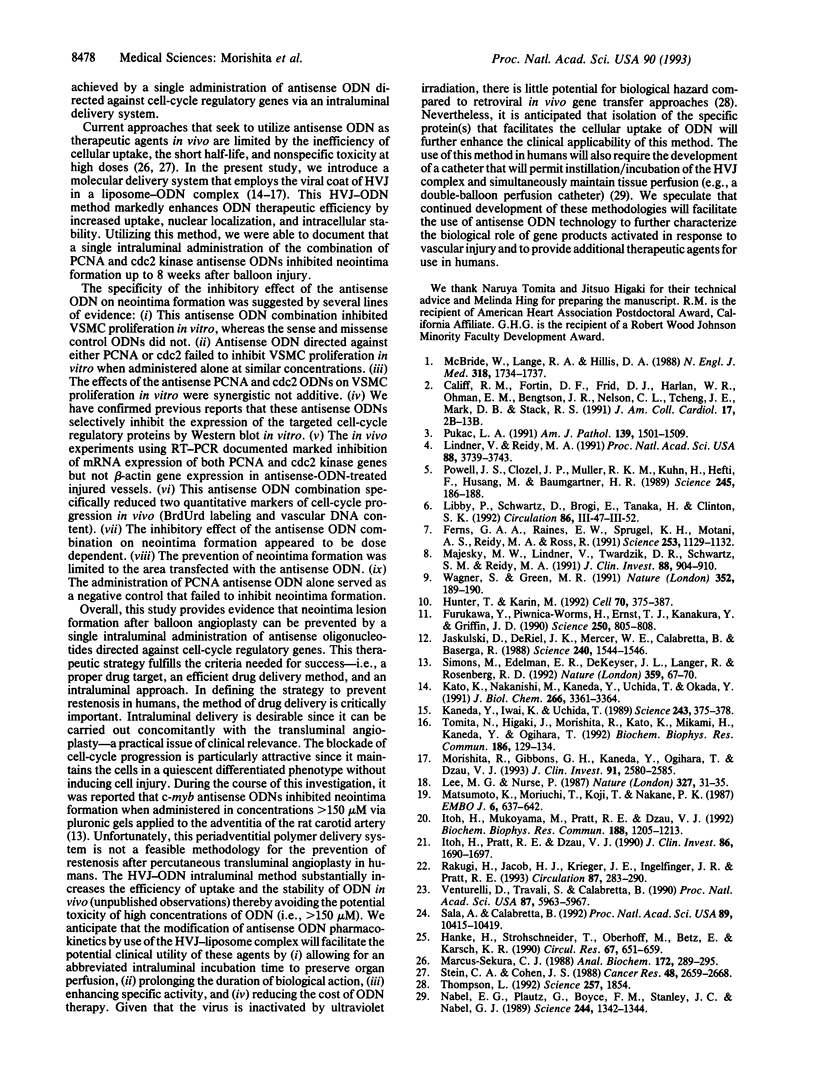Abstract
To develop an effective strategy to prevent neointima formation after angioplasty injury, we have identified cell-cycle regulatory proteins as targets for inhibition by using antisense oligonucleotides (ODNs). We utilized an intraluminal molecular delivery method that employs the protein coat of a Sendai virus complexed with liposomes that enhances markedly the efficiency of ODNs uptake. First, we examined the effect of antisense cdc2 kinase and proliferating-cell nuclear antigen (PCNA) ODNs in vitro. Cotransfection of antisense cdc2 kinase and PCNA ODNs inhibited serum-stimulated vascular smooth muscle cell growth, whereas antisense cdc2 kinase ODNs alone or PCNA ODNs alone failed to show any inhibitory effect. Transfection of the combination of antisense cdc2 kinase and PCNA ODNs into balloon-injured arteries in vivo provided a marked decrease in cdc2 and PCNA mRNA expression as determined by reverse transcription-PCR, compared to sense controls. Antisense ODN treatment significantly inhibited the increase in DNA synthesis induced by balloon injury. Moreover, antisense ODN administration inhibited completely neointima formation at 2 weeks after angioplasty in an apparent dose-dependent manner. Moreover, the inhibitory effect of antisense ODN on neointima formation persisted up to 8 weeks after a single transfection. The present study documents that a single intraluminal molecular delivery of combined cdc2 kinase and PCNA antisense ODNs results in a sustained inhibition of neointima formation in the rat carotid balloon-injury model.
Full text
PDF




Images in this article
Selected References
These references are in PubMed. This may not be the complete list of references from this article.
- Califf R. M., Fortin D. F., Frid D. J., Harlan W. R., 3rd, Ohman E. M., Bengtson J. R., Nelson C. L., Tcheng J. E., Mark D. B., Stack R. S. Restenosis after coronary angioplasty: an overview. J Am Coll Cardiol. 1991 May;17(6 Suppl B):2B–13B. doi: 10.1016/0735-1097(91)90933-z. [DOI] [PubMed] [Google Scholar]
- Ferns G. A., Raines E. W., Sprugel K. H., Motani A. S., Reidy M. A., Ross R. Inhibition of neointimal smooth muscle accumulation after angioplasty by an antibody to PDGF. Science. 1991 Sep 6;253(5024):1129–1132. doi: 10.1126/science.1653454. [DOI] [PubMed] [Google Scholar]
- Furukawa Y., Piwnica-Worms H., Ernst T. J., Kanakura Y., Griffin J. D. cdc2 gene expression at the G1 to S transition in human T lymphocytes. Science. 1990 Nov 9;250(4982):805–808. doi: 10.1126/science.2237430. [DOI] [PubMed] [Google Scholar]
- Hanke H., Strohschneider T., Oberhoff M., Betz E., Karsch K. R. Time course of smooth muscle cell proliferation in the intima and media of arteries following experimental angioplasty. Circ Res. 1990 Sep;67(3):651–659. doi: 10.1161/01.res.67.3.651. [DOI] [PubMed] [Google Scholar]
- Hunter T., Karin M. The regulation of transcription by phosphorylation. Cell. 1992 Aug 7;70(3):375–387. doi: 10.1016/0092-8674(92)90162-6. [DOI] [PubMed] [Google Scholar]
- Itoh H., Mukoyama M., Pratt R. E., Dzau V. J. Specific blockade of basic fibroblast growth factor gene expression in endothelial cells by antisense oligonucleotide. Biochem Biophys Res Commun. 1992 Nov 16;188(3):1205–1213. doi: 10.1016/0006-291x(92)91359-x. [DOI] [PubMed] [Google Scholar]
- Itoh H., Pratt R. E., Dzau V. J. Atrial natriuretic polypeptide inhibits hypertrophy of vascular smooth muscle cells. J Clin Invest. 1990 Nov;86(5):1690–1697. doi: 10.1172/JCI114893. [DOI] [PMC free article] [PubMed] [Google Scholar]
- Jaskulski D., deRiel J. K., Mercer W. E., Calabretta B., Baserga R. Inhibition of cellular proliferation by antisense oligodeoxynucleotides to PCNA cyclin. Science. 1988 Jun 10;240(4858):1544–1546. doi: 10.1126/science.2897717. [DOI] [PubMed] [Google Scholar]
- Kaneda Y., Iwai K., Uchida T. Increased expression of DNA cointroduced with nuclear protein in adult rat liver. Science. 1989 Jan 20;243(4889):375–378. doi: 10.1126/science.2911748. [DOI] [PubMed] [Google Scholar]
- Kato K., Nakanishi M., Kaneda Y., Uchida T., Okada Y. Expression of hepatitis B virus surface antigen in adult rat liver. Co-introduction of DNA and nuclear protein by a simplified liposome method. J Biol Chem. 1991 Feb 25;266(6):3361–3364. [PubMed] [Google Scholar]
- Lee M. G., Nurse P. Complementation used to clone a human homologue of the fission yeast cell cycle control gene cdc2. Nature. 1987 May 7;327(6117):31–35. doi: 10.1038/327031a0. [DOI] [PubMed] [Google Scholar]
- Lindner V., Reidy M. A. Proliferation of smooth muscle cells after vascular injury is inhibited by an antibody against basic fibroblast growth factor. Proc Natl Acad Sci U S A. 1991 May 1;88(9):3739–3743. doi: 10.1073/pnas.88.9.3739. [DOI] [PMC free article] [PubMed] [Google Scholar]
- Majesky M. W., Lindner V., Twardzik D. R., Schwartz S. M., Reidy M. A. Production of transforming growth factor beta 1 during repair of arterial injury. J Clin Invest. 1991 Sep;88(3):904–910. doi: 10.1172/JCI115393. [DOI] [PMC free article] [PubMed] [Google Scholar]
- Marcus-Sekura C. J. Techniques for using antisense oligodeoxyribonucleotides to study gene expression. Anal Biochem. 1988 Aug 1;172(2):289–295. doi: 10.1016/0003-2697(88)90447-2. [DOI] [PubMed] [Google Scholar]
- Matsumoto K., Moriuchi T., Koji T., Nakane P. K. Molecular cloning of cDNA coding for rat proliferating cell nuclear antigen (PCNA)/cyclin. EMBO J. 1987 Mar;6(3):637–642. doi: 10.1002/j.1460-2075.1987.tb04802.x. [DOI] [PMC free article] [PubMed] [Google Scholar]
- McBride W., Lange R. A., Hillis L. D. Restenosis after successful coronary angioplasty. Pathophysiology and prevention. N Engl J Med. 1988 Jun 30;318(26):1734–1737. doi: 10.1056/NEJM198806303182606. [DOI] [PubMed] [Google Scholar]
- Morishita R., Gibbons G. H., Kaneda Y., Ogihara T., Dzau V. J. Novel and effective gene transfer technique for study of vascular renin angiotensin system. J Clin Invest. 1993 Jun;91(6):2580–2585. doi: 10.1172/JCI116496. [DOI] [PMC free article] [PubMed] [Google Scholar]
- Nabel E. G., Plautz G., Boyce F. M., Stanley J. C., Nabel G. J. Recombinant gene expression in vivo within endothelial cells of the arterial wall. Science. 1989 Jun 16;244(4910):1342–1344. doi: 10.1126/science.2499928. [DOI] [PubMed] [Google Scholar]
- Powell J. S., Clozel J. P., Müller R. K., Kuhn H., Hefti F., Hosang M., Baumgartner H. R. Inhibitors of angiotensin-converting enzyme prevent myointimal proliferation after vascular injury. Science. 1989 Jul 14;245(4914):186–188. doi: 10.1126/science.2526370. [DOI] [PubMed] [Google Scholar]
- Pukac L. A., Hirsch G. M., Lormeau J. C., Petitou M., Choay J., Karnovsky M. J. Antiproliferative effects of novel, nonanticoagulant heparin derivatives on vascular smooth muscle cells in vitro and in vivo. Am J Pathol. 1991 Dec;139(6):1501–1509. [PMC free article] [PubMed] [Google Scholar]
- Rakugi H., Jacob H. J., Krieger J. E., Ingelfinger J. R., Pratt R. E. Vascular injury induces angiotensinogen gene expression in the media and neointima. Circulation. 1993 Jan;87(1):283–290. doi: 10.1161/01.cir.87.1.283. [DOI] [PubMed] [Google Scholar]
- Sala A., Calabretta B. Regulation of BALB/c 3T3 fibroblast proliferation by B-myb is accompanied by selective activation of cdc2 and cyclin D1 expression. Proc Natl Acad Sci U S A. 1992 Nov 1;89(21):10415–10419. doi: 10.1073/pnas.89.21.10415. [DOI] [PMC free article] [PubMed] [Google Scholar]
- Simons M., Edelman E. R., DeKeyser J. L., Langer R., Rosenberg R. D. Antisense c-myb oligonucleotides inhibit intimal arterial smooth muscle cell accumulation in vivo. Nature. 1992 Sep 3;359(6390):67–70. doi: 10.1038/359067a0. [DOI] [PubMed] [Google Scholar]
- Stein C. A., Cohen J. S. Oligodeoxynucleotides as inhibitors of gene expression: a review. Cancer Res. 1988 May 15;48(10):2659–2668. [PubMed] [Google Scholar]
- Thompson L. Gene therapy. Monkey tests spark safety review. Science. 1992 Sep 25;257(5078):1854–1854. doi: 10.1126/science.1411498. [DOI] [PubMed] [Google Scholar]
- Tomita N., Higaki J., Morishita R., Kato K., Mikami H., Kaneda Y., Ogihara T. Direct in vivo gene introduction into rat kidney. Biochem Biophys Res Commun. 1992 Jul 15;186(1):129–134. doi: 10.1016/s0006-291x(05)80784-3. [DOI] [PubMed] [Google Scholar]
- Venturelli D., Travali S., Calabretta B. Inhibition of T-cell proliferation by a MYB antisense oligomer is accompanied by selective down-regulation of DNA polymerase alpha expression. Proc Natl Acad Sci U S A. 1990 Aug;87(15):5963–5967. doi: 10.1073/pnas.87.15.5963. [DOI] [PMC free article] [PubMed] [Google Scholar]
- Wagner S., Green M. R. Retinoblastoma. A transcriptional tryst. Nature. 1991 Jul 18;352(6332):189–190. doi: 10.1038/352189a0. [DOI] [PubMed] [Google Scholar]




